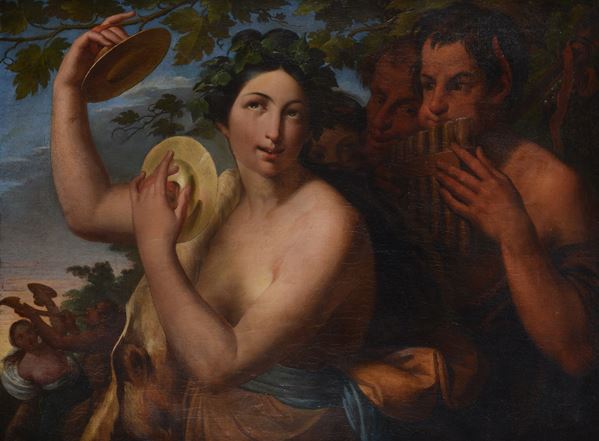Karl Pavlovič Brjullov ( San Pietroburgo, 1799 - Manziana, 1852)
Bacchanal
"A suggestive clue for the attribution of this painting to Karl Pavlovich Brjullov is the evident similarity, physiognomic but also stylistic, between the Bacchante with the timpani at the center of the scene and two female figures present in works from the 1930s Russian painter: The portrait of Princess Ekaterina Pavlovna Bagration (1849), whose face has the same symmetry based on the superciliary arches that converge on the elongated nose towards the gracefully posed mouth; and the Portrait of the painter in a boat with Baroness Yekaterina Meller - Zakomelsky , where the noblewoman turns to the viewer with a dreamy gaze, highlighting the same somatic characteristics of the previous one and of our mythological creature. A comparison that leads us to place this painting in a time span that includes, in part, Brjullov's Italian stay which began in 1823 and concluded in 1835: a period of fundamental formative experiences which saw the painter traveling between Venice, Bologna and Florence where he had all the leisure to study the masters from whom he would draw stylistic and compositional ideas especially for his historical genre paintings. Among these, the monumental painting depicting The Last Days of Pompeii (1827 - 1833) stands out, conceived following a visit to the Pompeian excavations which took place in the company of Prince Anatoly Demidov who was to be one of Brjullov's most loyal clients, hosting among other things in the sumptuous Villa of San Donato in Florence, some of his portraits of notable importance. The Bacchanal, in addition to the similarities mentioned, can find further evidence in the interest in Bacchic subjects demonstrated by the artist in some drawings dating back to the 1930s; while the formal politeness that accompanies the chromatic application with warm and suffused tones leads us to suppose the painter's understanding of the Venetian and Bolognese masters matured in the remembered travels and which began, in Rome, with Raphael's studio of which Brjullov will copy with successes of the School of Athens. Also for this Bacchanal, which remained in Italian territory, one could hypothesize that it was commissioned by Prince Demidov who we know was attracted by Bacchic themes, as attested by the Bacchae by James Pradier presented in his Florentine collection; but also passionate about the French painting of his time with preferences towards Delacroix, Decamps, Troyon and the successful genre painting of Horace Vernet to whom Brjullov himself showed himself to refer in paintings such as Italian Midday and Girl Picks Grapes in the Surroundings of Naples, both of 1827, where vine pergolas form the backdrop, as in our painting, to the transfigured visions of Italy of the Grand Tour. When closing the entry with a convinced attribution to Brjullov, a brilliant intuition of Francesco Taddei identified the foul-mouthed satyr and mocking behind the bacchante is the self-portrait of the artist which can be seen from the comparison with the one preserved in the Tretyakov Gallery in Moscow, sulphurous and already predisposed to further disguises as our painting demonstrates, therefore to be considered an escape into the Mediterranean myth pursued by Brjullov during the years of his passionate Italian experience."
Chart by Carlo Sisi.






